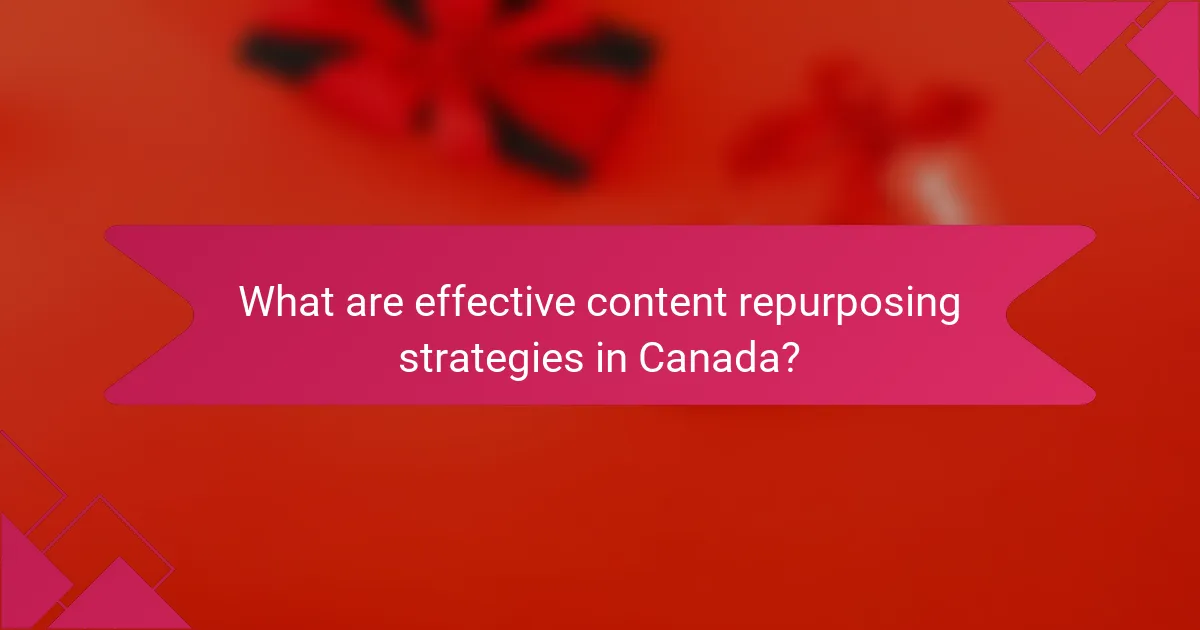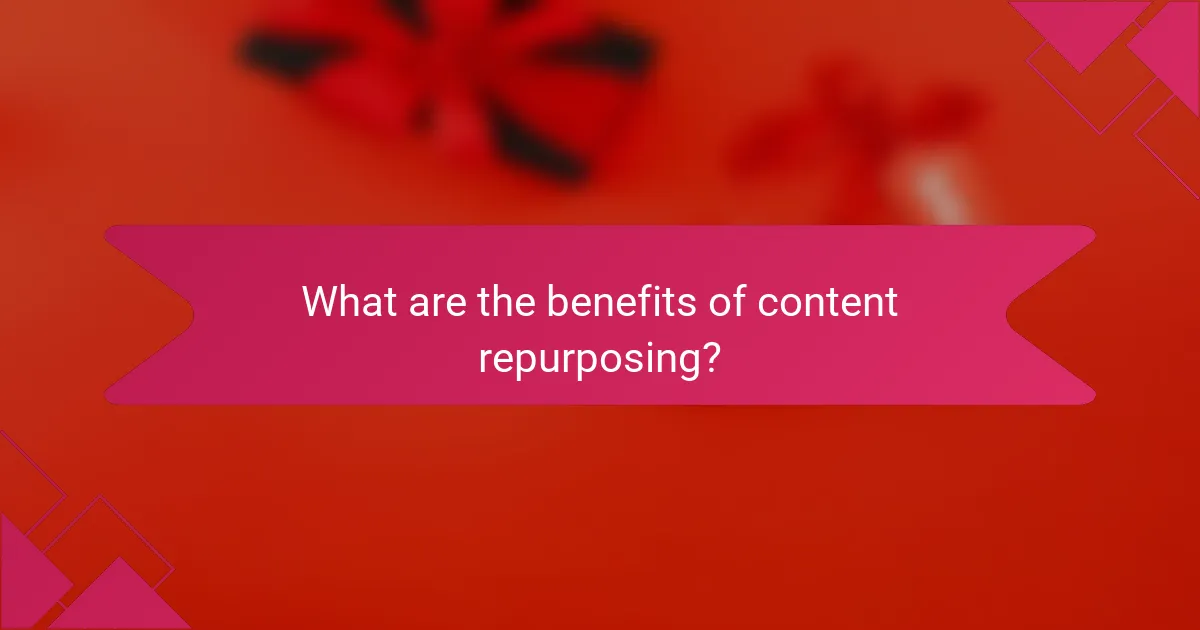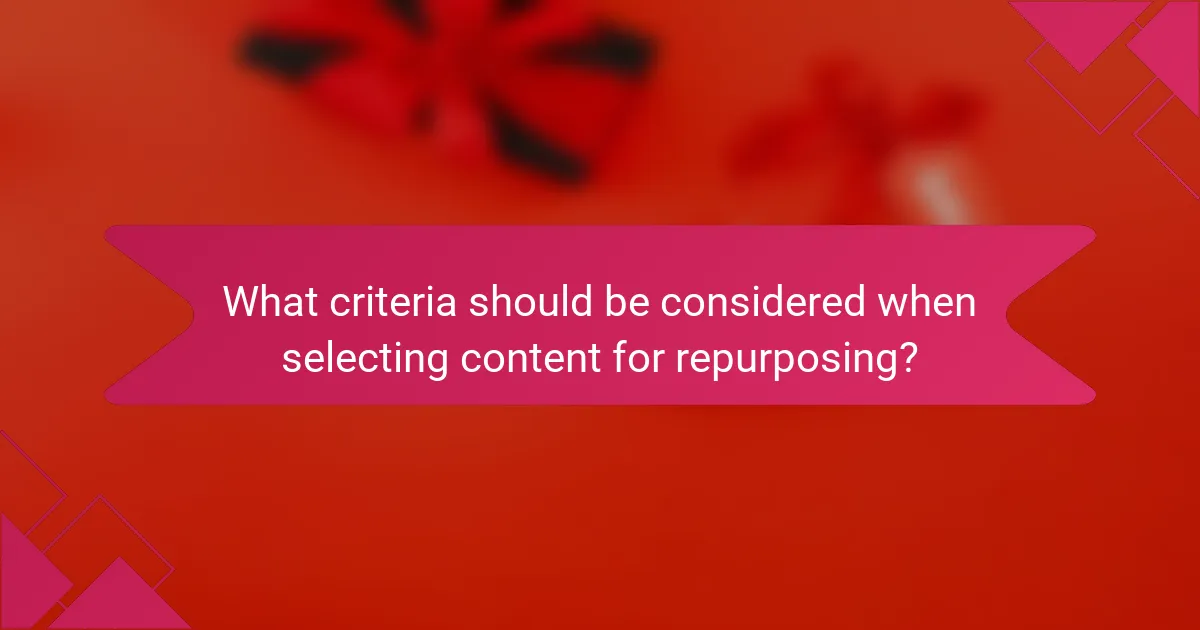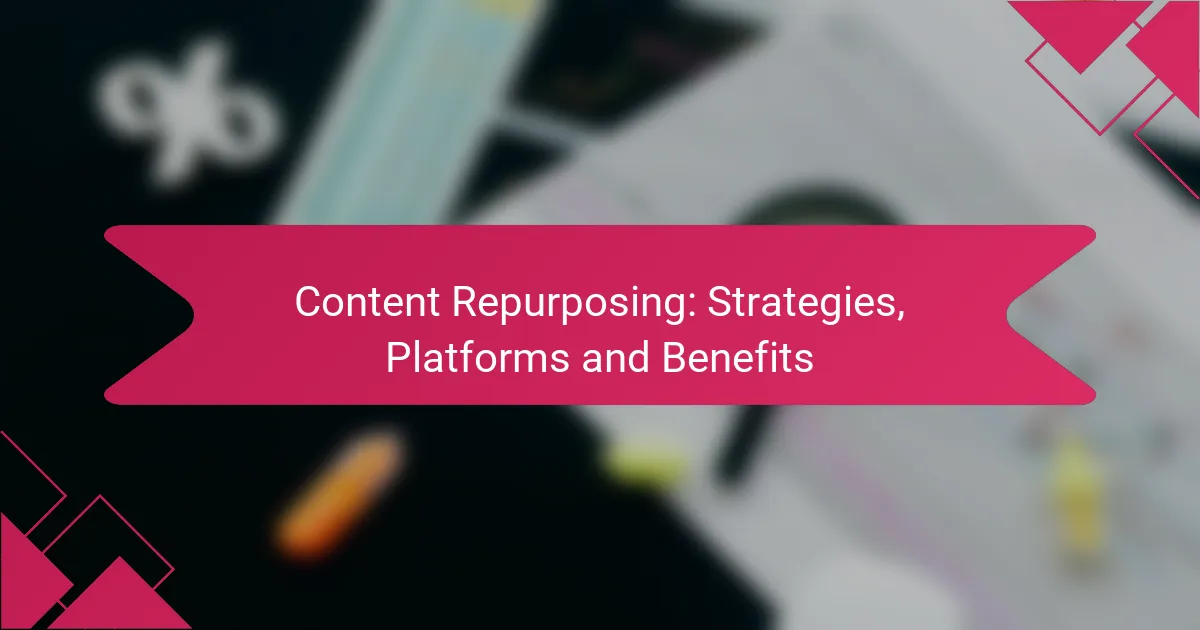Content repurposing is a strategic approach that involves transforming existing materials into various formats to engage different audiences effectively. By utilizing specific platforms designed for this purpose, creators can maximize their content’s reach and enhance its value. This method not only saves time but also improves engagement and visibility across multiple channels.

What are effective content repurposing strategies in Canada?
Effective content repurposing strategies in Canada involve transforming existing content into various formats to reach different audiences and maximize engagement. This approach not only saves time but also enhances the value of your original content by presenting it in diverse ways.
Transforming blog posts into videos
Transforming blog posts into videos can significantly increase audience engagement. Start by summarizing key points from your blog and creating a script. Use visuals and voiceovers to enhance the message, and consider platforms like YouTube or Vimeo for distribution.
When creating videos, aim for a duration of 3 to 5 minutes to maintain viewer interest. Ensure that your visuals align with the content to reinforce your message effectively.
Creating infographics from research articles
Infographics are a powerful way to present complex information from research articles in a visually appealing format. Identify the main data points and insights, then use design tools like Canva or Piktochart to create your infographic.
Keep your infographic concise, focusing on 3 to 5 key takeaways. This format is particularly effective for sharing on social media platforms, where visual content tends to perform better.
Turning podcasts into written content
Turning podcasts into written content involves transcribing episodes or summarizing discussions into articles or blog posts. This strategy allows you to reach audiences who prefer reading over listening.
Consider using transcription services or software to streamline the process. Highlight key quotes and insights from the podcast to enrich the written content and provide additional value to readers.
Utilizing social media snippets
Utilizing social media snippets involves extracting key quotes or highlights from your content and sharing them on platforms like Twitter, Instagram, or LinkedIn. This strategy can drive traffic back to your original content while engaging your audience with bite-sized information.
Focus on creating visually appealing graphics or short videos for these snippets. Aim for a frequency of 2 to 3 posts per week to maintain visibility without overwhelming your audience.
Developing eBooks from existing content
Developing eBooks from existing content allows you to compile related articles or blog posts into a comprehensive guide. This format can be offered as a downloadable resource, enhancing your brand’s authority and providing value to your audience.
Organize your content into chapters, and include additional insights or case studies to enrich the eBook. Consider using platforms like Amazon Kindle Direct Publishing for distribution, and promote it through your website and social media channels.

Which platforms facilitate content repurposing?
Several platforms effectively facilitate content repurposing by providing tools tailored for different media types. These platforms streamline the process, allowing creators to maximize their content’s reach and engagement across various channels.
Canva for visual content
Canva is an intuitive design platform that enables users to create stunning visuals from existing content. You can transform blog posts into infographics or social media graphics in just a few clicks, utilizing its extensive library of templates and design elements.
To get started, select a template that fits your content type, customize it with your text and images, and download it in your preferred format. Remember to maintain brand consistency by using your color palette and fonts.
Hootsuite for social media management
Hootsuite is a powerful tool for scheduling and managing social media posts, making it easier to repurpose content across different platforms. You can take a single piece of content, such as a blog post, and create multiple posts tailored for each social media channel.
Utilize Hootsuite’s analytics to determine the best times to post and track engagement metrics. Avoid overwhelming your audience by spacing out posts and varying the messaging to keep it fresh.
Anchor for podcast distribution
Anchor is a user-friendly platform for turning written content into podcasts. By recording audio versions of your articles or blog posts, you can reach audiences who prefer listening over reading.
To repurpose effectively, consider breaking down longer pieces into shorter episodes and adding personal insights or interviews to enhance engagement. Ensure you promote your podcast on social media to attract listeners.
WordPress for blog management
WordPress is a versatile content management system that allows for easy repurposing of existing blog posts. You can update older articles with new information or convert them into different formats, such as downloadable guides or eBooks.
Utilize plugins to optimize SEO and enhance user experience. Regularly revisiting and refreshing content can improve your site’s visibility and keep your audience engaged.
Adobe Premiere for video editing
Adobe Premiere is a professional video editing software that allows you to repurpose content into engaging video formats. You can create highlight reels from webinars, transform blog content into explainer videos, or compile customer testimonials.
When editing, focus on keeping videos concise and visually appealing. Use captions for accessibility and consider adding background music to enhance the viewing experience. Always export in formats suitable for your target platforms.

What are the benefits of content repurposing?
Content repurposing offers numerous advantages, including maximizing the value of existing content, reaching new audiences, and improving overall engagement. By transforming content into various formats, brands can enhance visibility and effectiveness while saving time and resources.
Increased audience reach
Repurposing content allows you to connect with different segments of your audience across various platforms. For example, a blog post can be transformed into a video, infographic, or social media post, catering to diverse preferences and increasing the chances of engagement.
Consider using platforms like Instagram, LinkedIn, or TikTok to share repurposed content, as each platform attracts unique demographics. This strategy can significantly expand your audience reach and enhance brand awareness.
Enhanced SEO performance
Repurposing content can improve your website’s SEO by generating more backlinks and increasing dwell time. When you create multiple formats of the same content, you provide more opportunities for search engines to index your material, which can lead to higher rankings.
For instance, turning a well-performing blog post into a podcast or video can attract different types of traffic, ultimately boosting your site’s authority and relevance in search results.
Cost-effectiveness in content creation
Repurposing existing content is often more cost-effective than creating new material from scratch. By leveraging previously created assets, you can save time and resources while still delivering valuable information to your audience.
For example, if you have a series of articles, consider compiling them into an eBook. This not only provides a new format but also adds value for your audience without the need for extensive new research or writing.
Improved content lifespan
Repurposing extends the lifespan of your content by allowing it to be relevant across different contexts and timeframes. A single piece of content can be refreshed and reused in various ways, ensuring it remains useful and engaging for a longer period.
For instance, seasonal content can be updated and republished annually, while evergreen content can be adapted into new formats or updated with fresh information to maintain its relevance. This approach maximizes the return on investment for your content efforts.

What criteria should be considered when selecting content for repurposing?
When selecting content for repurposing, focus on its relevance to your target audience and its performance metrics. These criteria help ensure that the content resonates with viewers and has proven effective in achieving engagement or conversions.
Content relevance to target audience
Assessing content relevance involves understanding your audience’s interests, needs, and pain points. Content that addresses current trends or frequently asked questions is more likely to engage viewers. Consider conducting surveys or analyzing social media interactions to gauge what topics resonate most.
For example, if your audience is primarily interested in sustainable living, repurposing blog posts on eco-friendly practices into infographics or videos can attract their attention. Ensure that the repurposed content maintains the original message while adapting to different formats.
Performance metrics of existing content
Reviewing performance metrics helps identify which pieces of content have driven traffic, engagement, or conversions. Key metrics include page views, social shares, and conversion rates. Focus on content that has performed well historically, as it is more likely to succeed when repurposed.
For instance, if a particular article generated high traffic but low engagement, consider transforming it into a video or a podcast episode to enhance viewer interaction. Utilize analytics tools to track these metrics effectively and make data-driven decisions on what to repurpose.










